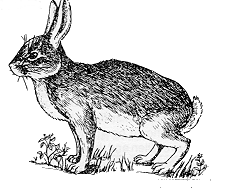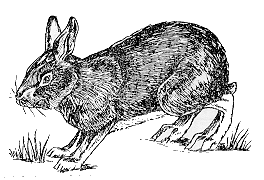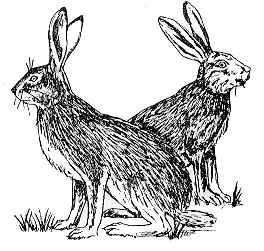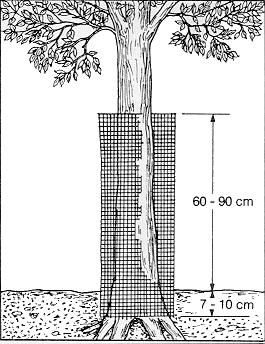| | Biology | Damage | Damage prevention
Orchards, nurseries, shelterbelts and gardens can suffer economic losses and esthetic damage because of gnawing animals.
Most damage occurs from late fall until early spring when extreme weather conditions limit the available food supply. Plant damage can also be extensive during periods of drought or when rabbit and hare populations are high.
Biology
Rabbits and hares belong to the order Lagomorpha. Unlike rodents, all lagomorphs have two pair of upper incisors or front teeth. The second set of incisors are small and peg-like, located directly behind the first incisors.
Rabbits can be differentiated from hares by their appearance at birth. Rabbits are born helpless, naked and blind, while hares are born fully furred, able to see and capable of independent movement. Alberta has one species of native rabbit and two species of native hares.

Figure 1. Cottontail rabbit
Cottontail rabbits are found throughout the southern arid regions of the province and are Alberta's only true rabbit (Figure 1). They inhabit thick bushy areas such as coulees, river bottoms, sagebrush plains and abandoned farmsteads.
Cottontail rabbits have a brown fur coat that remains the same color year-round. Adults may weight over 1 kg each. Mating begins in February and ends after the summer. On average, five young are born per litter, and three or more litters can be raised every year. Sexual maturity is reached early, at two to three months of age.

Figure 2. Snowshoe hare
Snowshoe hares are found throughout Alberta except in the arid central and southern areas of the province (Figure 2). These hares prefer a habitat that contains dense stands of woody shrubs, typical of the forest and parkland regions.
Adults may weigh up to 2 kg each. The fur color of snowshoe hares is greyish brown in summer and changes to white in winter. An average of four young are born per litter, and up to three litters can be raised each year. Juveniles will not breed in their first year of life.
Snowshoe hares are noted for tremendous population fluctuations. In peak years, their numbers have reached levels as great as 4,000 hares/km2. These populations will peak and decline over an 8 to 11 year cycle.

Figure 3. White-tailed Jackrabbit
White-tailed jackrabbits or prairie hares are found throughout the prairies, parkland and cultivated regions of Alberta (Figure 3). Jackrabbits prefer an open habitat because they depend on their running speed for protection from enemies.
Adults may weigh as much as 3.5 kg each. The fur color of prairie hares changes from brownish grey in the summer to white in the winter. An average of four young are born per litter, and one or two litters are raised every year.
Damage
Rabbits and hares are herbivores that feed on most broad-leaved plants and grasses. During the winter when green vegetation is unavailable, rabbits will change to browsing on buds, bark and small twigs.
Landscape trees, shelter-belts, orchards and plantations suffer at this time because the rabbits may girdle young stems or completely prune buds and shoots. Evergreen trees and seedlings are not immune to rabbit damage either. Gnawing on the bark of woody plants can be a direct or contributory cause of plant mortality. Severe pruning by hares and rabbits may also result in undesirable regrowth.
Damage Prevention
Rabbit damage can be reduced or prevented by the removal of the offending animals, modification of the existing habitat or animal exclusion by means of mechanical barriers.
Animal removal
Animal removal may be effective when damage is caused by a few animals or when combined with other preventive measures.
- Shooting: Rabbits and hares can be hunted year-round without a licence. Early morning or late evening are the best times of day to shoot rabbits. The .22 calibre rifle and shotgun are the most commonly used firearms for this purpose. Consult municipal authorities for local firearm restrictions.
- Trapping: Live traps are ideal for removing rabbits and hares in an urban setting. Wooden box traps work well for rabbits but not hares (Figure 4). An open mesh live trap is required for hares (Figure 5). Good winter baits include corn on the cob, dried apples, alfalfa and clover. Successful warm weather baits include carrots, lettuce, cabbage and apples. Jackrabbits can be captured in funnel pen traps constructed of poultry wire. The funnel trap must be at least 1 m high and 3 m in diameter, with the top completely enclosed to prevent rabbits from jumping out. It is illegal to use leghold traps to catch rabbits or hares in Alberta, unless a damage control permit is obtained through the local Fish and Wildlife Division of Alberta Sustainable Resource Development.
- Snaring: The use of snares to take rabbits and hares is legal, provided the snares are constructed of single-strand wire, 20 gauge or greater, and the snare loop diameter is not greater than 13 cm. Check snares daily.
- Toxicants: It is illegal to poison rabbits or hares in Alberta.
Figure 5. Open mesh hare trap
Modification of existing habitat
- Removal of undergrowth: Cottontail rabbits and snowshoe hares need brushy cover for protection. Removing non-essential undergrowth and debris will eliminate the shelter where rabbits and hares live.
- Change of crops: Continuous or severe plant damage may warrant a change to less susceptible plant species. For garden crops, this approach may mean changing to corn, squash, cucumbers, tomatoes or potatoes. Unfortunately, most fruit and ornamental trees of the rose family are not immune to rabbit damage.
- Use of repellents: Repellents make plants distasteful to rabbits and hares. Two chemical repellents are currently registered for use in Alberta. Two different formulations (with different ingredients) of thiram are both sold under the product name: SKOOT.
An effective repellent can be made at home by mixing 1 part thiram wettable powder with 10 parts by weight of water-emulsifiable black asphalt.
Repellents should be applied in the late fall when the leaves have fallen and the bark on the trees is dry. They can be applied by sprayer or paintbrush and will provide up to one season's protection. The air temperature should be above freezing when the repellent is applied. Thoroughly cover all plant parts susceptible to rabbit feeding up to a level above the potential height of the snow line. Do not apply to plants grown for human or animal consumption. Repellent-treated plants are inedible.
Exclusion
Rabbits and hares can be kept away from vegetation by mechanical barriers (Figure 6). Place a 1 m high fence of poultry mesh around small gardens, orchards and plantations. Bury the bottom edge of the mesh 7 to 10 cm into the ground to prevent rabbits from digging under the fence. Do not brace the poultry mesh against tree trunks because rabbits can feed through the holes.
Hardware cloth (0.6 cm mesh) is an excellent barrier. It should be set 7 to 10 cm into the ground and extend 1 m above the potential snow line to prevent rabbit damage. The fine mesh of hardware cloth will also protect trees and shrubs from mice and voles.

Figure 6. Mechanical barrier
Source: Agdex 684-12. Revised July 2005.
|
|